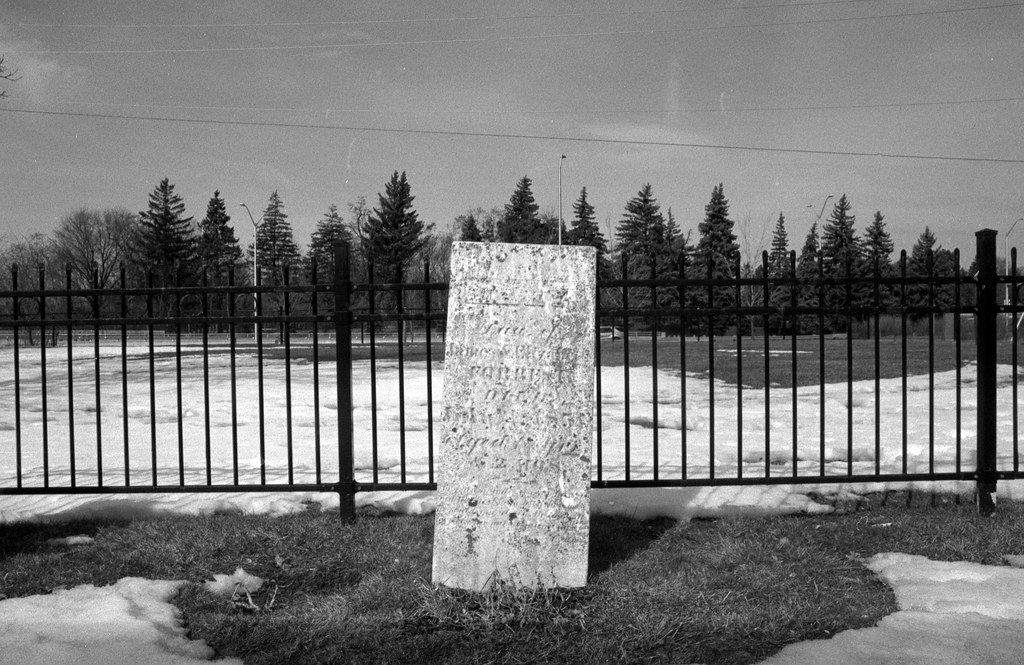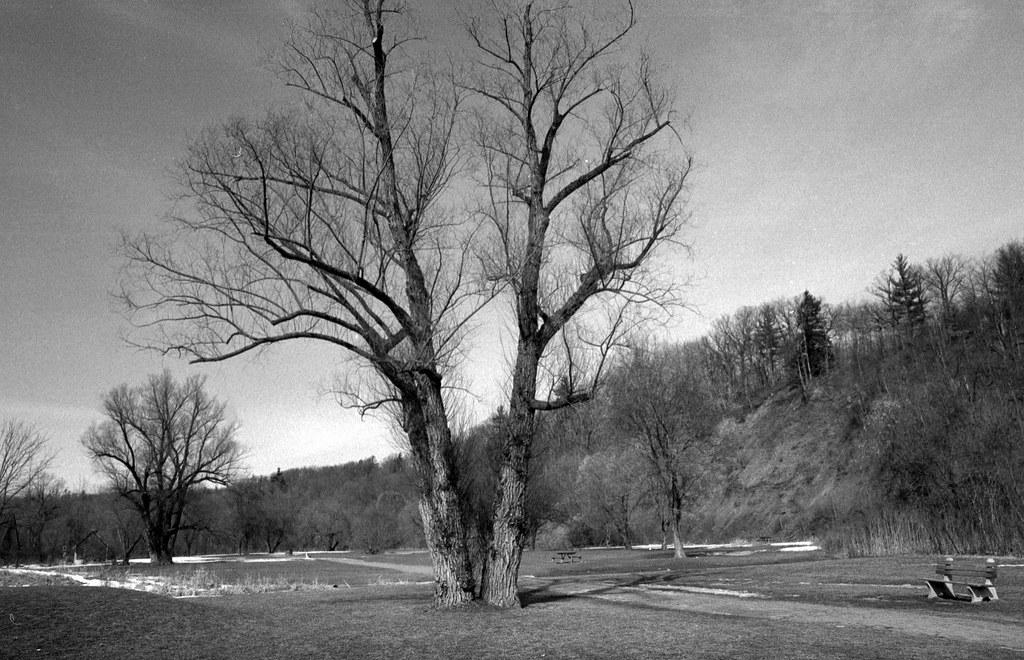I should have known that the park would be closed as I pulled into the small out of the way intersection on Dundas Street. I didn’t have much time actually to get out and take pictures, and it was a ten-minute drive to and at least another ten-minute drive back. That left me a half hour to actually do some shooting. That left me five minutes down and five minutes back, and I would need that time. The yellow gates closed, and the pile of snow surrounding it said that I would need to hike into Sixteen Hollow. There’s something mysterious about a ghost town, and there’s one right in Oakville, under the noses of everyone but with nothing but a church to mark its former place.

Nikon FM – AI Nikkor 28mm 1:3.5 (Yellow-12) – Fompan 200 @ ASA-200 – FA-1027 (1+19) 10:30 @ 20C
The Dundas Road, formed in 1795, can be considered the first highway in Upper Canada. Commissioned by John Graves Simcoe, the road connected York (Toronto) to Newark (Niagara-On-The-Lake). It was along this road that settlements, especially those near running water, would spring up. One such village rose in 1825, settled by George Chalmers; Chalmers would build a grist mill and store. Like most mills, a small village quickly grew up and took the name Chalmers Mill. Residents set up houses, services like a tavern, blacksmith, stables, and a distillery sprung up to serve the small but thriving community. Even William Lyon MacKenzie passed through on his escape from Toronto in 1837, very nearly getting caught by Government Loyalists while crossing the Sixteen. Chalmers overextended himself and sold off his holdings to Thomas Proudfoot in the 1840s, the village took the name Proudfoot’s Hollow, and by the middle of the decade Sixteen Hollow or simply Sixteen. The only church, a Presbyterian congregation, built a wood frame meeting house in 1844. By the middle of the century, a three-storey inn and stagecoach station offered rest for travellers, and a small bustling industrial community thrived through the 1850s and 1870s. But when the railroad came, it did not come anywhere near Sixteen. Combined with a sudden drop in the grain industry, the village slowly died. Through the 1880s, the mill closed along with all the businesses. Residents packed up and left, and by the end of the decade, the only place that survived was the Presbyterian Church. And while the village itself vanished, a new Bridge spanned the Sixteen Mile Creek in 1885, replaced in 1921 and again in 2008 to carry the Dundas Road (later Highway 5 and now Dundas Street). Today, other than the church Knox Sixteen, there is nothing left but a massive open park named Lions Valley.

Nikon FM – AI Nikkor 28mm 1:3.5 (Yellow-12) – Fompan 200 @ ASA-200 – FA-1027 (1+19) 10:30 @ 20C
Nikon FM – AI Nikkor 28mm 1:3.5 (Yellow-12) – Fompan 200 @ ASA-200 – FA-1027 (1+19) 10:30 @ 20C
Having the entire park to myself was a blessing. I only ever saw people leaving as I entered and going in as I left. It helped give a sense of place, given that I was walking through a ghost town, having no sign that it once stood there. I had to use my imagination to put where the mill once stood as the Sixteen Mile Creek rushed by or picture where the original 1858 bridge stood. And the shallow parts where William Lyon MacKenzie avoided capture. Sadly, because there is nothing left, actually finding interesting captures proved difficult. Thankfully, there is still a lot of things to photograph. The featured image is one that I shot walking down the steep roadway into the park, catching the Highway 5 (Dundas Road) bridge that flies over the Sixteen Valley and is a major feature in the park itself. Following that are two images from above the park itself: Knox Sixteen and a lone old gravestone that are the only reminders of the village that once occupied the area. Next is a closer look at the surviving 1921 Highway Five bridge that was replaced in 2008 and one of several old trees that were left in place, probably having stood since the village existed. The third and final set was further into the park, showing the Sixteen Mile Creek and a heavily wooded area that occupies the western edge of the creek valley wall. And while it is fairly open now, back in the summer, it is a rather quiet place that reminds you of what it used to be.

Nikon FM – AI Nikkor 28mm 1:3.5 (Yellow-12) – Fompan 200 @ ASA-200 – FA-1027 (1+19) 10:30 @ 20C
Nikon FM – AI Nikkor 28mm 1:3.5 (Yellow-12) – Fompan 200 @ ASA-200 – FA-1027 (1+19) 10:30 @ 20C
Here we are in the second week of Fomapan 200, and I’m starting to learn a little more about the film stock. Being in a mixed environment, I shot the film at box speed, ASA-200. While I originally planned to bring a few lenses but ended up giving that idea up opting instead for a single wide-angle (28mm) lens. Although I did wish I had a 50mm on hand in a couple of cases, mostly in the Knox Sixteen Cemetery. With the bright sun and partly cloudy skies, I went with a yellow filter to help give some separation between the clouds and the sky and bump up that contrast. Even still, I was shooting around f/8 to f/16 and shutter speeds between 1/125″ and 1/250″. For the developer, I went with FA-1027, a compensating developer that did an okay job with Fomapan 400 and worked magic on Fomapan 200.

Nikon FM – AI Nikkor 28mm 1:3.5 (Yellow-12) – Fompan 200 @ ASA-200 – FA-1027 (1+19) 10:30 @ 20C
Nikon FM – AI Nikkor 28mm 1:3.5 (Yellow-12) – Fompan 200 @ ASA-200 – FA-1027 (1+19) 10:30 @ 20C
Are you getting tired of Halton Region? Don’t worry; I’m getting tired of Halton as well! But next week, we’re spreading our wings a little bit and heading into one of my favourite historic downtowns!